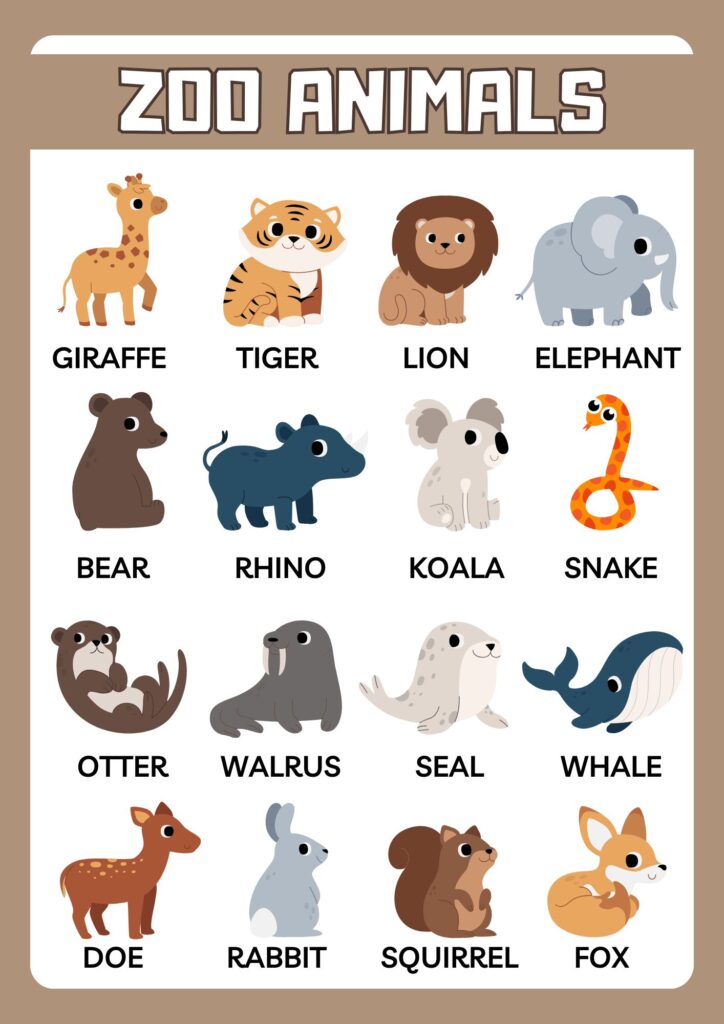Zoo Animals: A Comprehensive Guide
This article looks at common zoo animals that draw millions of visitors each year. Understanding these animals improves the zoo experience and helps people appreciate wildlife conservation.
Introduction to Common Zoo Animals
Zoos help us learn about wildlife by displaying animals like lions and elephants. Lions live in groups called prides, showing strong family ties and teamwork when hunting. zoo animals encourages conversations about conservation and protecting their habitats. Elephants are smart animals that use low sounds to communicate and show empathy.

Visiting zoo animals makes us think about the ethics of keeping sentient beings in captivity and highlights their importance in the ecosystem. By connecting with these zoo animals, zoos motivate us to support wildlife conservation and turn learning into action.
A list of Common Zoo Animals
Here’s a list of common zoo animals you can find around the world.
1. African Elephant
2. Asian Elephant
3. Lion
4. Tiger
5. Leopard
6. Cheetah
7. Jaguar
8. Snow Leopard
9. Panther
10. Puma
11. Giraffe
12. Zebra
13. Hippopotamus
14. Rhinoceros
15. Bison
16. Buffalo
17. Antelope
18. Gazelle
19. Moose
20. Reindeer
21. Camel
22. Llama
23. Alpaca
24. Okapi
25. Tapir
26. Sloth
27. Giant Anteater
28. Armadillo
29. Koala
30. Kangaroo
31. Wallaby
32. Wombat
33. Red Panda
34. Giant Panda
35. Hyena
36. Meerkat
37. Lemur
38. Capybara
39. Beaver
40. Otter
41. Raccoon
42. Hedgehog
43. Porcupine
44. Prairie Dog
45. Badger
46. Mongoose
47. Fox
48. Wolf
49. Wild Boar
50. Fennec Fox
51. Chimpanzee
52. Gorilla
53. Orangutan
54. Baboon
55. Mandrill
56. Capuchin Monkey
57. Howler Monkey
58. Spider Monkey
59. Squirrel Monkey
60. Tamarin
61. Peacock
62. Flamingo
63. Parrot
64. Macaw
65. Cockatoo
66. Owl
67. Eagle
68. Hawk
69. Falcon
70. Vulture
71. Toucan
72. Hornbill
73. Pelican
74. Stork
75. Crane
76. Swan
77. Duck
78. Goose
79. Emu
80. Ostrich
81. Cassowary
82. Kiwi
83. Secretary Bird
84. Pigeon
85. Dove
86. Komodo Dragon
87. Crocodile
88. Alligator
89. Monitor Lizard
90. Chameleon
91. Iguana
92. Gecko
93. Green Anole
94. Tortoise
95. Turtle
96. Snake (generic)
97. Python
98. Boa Constrictor
99. King Cobra
100. Rattlesnake
101. Frog
102. Toad
103. Salamander
104. Newt
105. Axolotl
106. Dolphin
107. Sea Lion
108. Seal
109. Walrus
110. Penguin
111. Otter
112. Clownfish
113. Pufferfish
114. Jellyfish
115. Seahorse
116. Octopus
117. Squid
118. Starfish
119. Shark
120. Stingray
121. Moray Eel
122. Sea Turtle
123. Crab
124. Lobster
125. Coral (in tanks)
126. Butterfly
127. Moth
128. Beetle
129. Stick Insect
130. Praying Mantis
131. Scorpion
132. Tarantula
133. Ants (in farms)
134. Grasshopper
135. Ladybug
136. Aardvark
137. Pangolin
138. Kinkajou
139. Bush Baby
140. Tenrec
141. Civet
142. Serval
143. Caracal
144. Dhole
145. Maned Wolf
146. Quokka
147. Platypus
148. Echidna
149. Agouti
150. Margay

What are some of the most common animals found in zoos?
Common zoo animals include lions, tigers, elephants, giraffes, zebras, bears, monkeys, and various species of birds and reptiles.
How do zoos ensure the health and well-being of their animals?
Zoos provide veterinary care, proper nutrition, enrichment activities, and spacious habitats to promote physical and mental well-being.
How do zoos contribute to wildlife conservation?
Zoos engage in breeding programs, research, habitat preservation, and education initiatives to support global conservation efforts.
Are the animals in zoos kept in cages?
Modern zoos often use naturalistic enclosures that mimic the animals’ natural habitats rather than traditional cages, promoting more natural behaviors.
What is the role of zookeepers?
Zookeepers are responsible for the daily care of animals, including feeding, cleaning, monitoring health, and providing enrichment activities.
How can visitors learn more about the animals in the zoo?
Zoos offer educational programs, guided tours, and informational signage throughout exhibits to enhance visitor knowledge about the animals.


